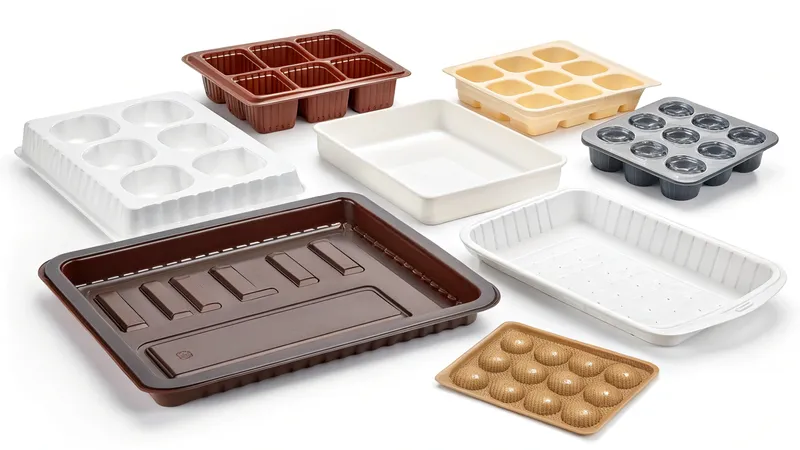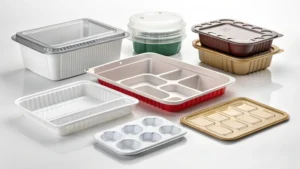
Vakuumformung und Druckformung1 are both thermoforming processes2 used to shape plastic sheets into desired forms, offering manufacturers versatile solutions for creating everything from packaging to intricate components. While they share some similarities, their differences in technique and capabilities make them suited to distinct applications.
Vacuum forming uses suction to pull heated plastic sheets onto a mold, making it ideal for large, simple parts like packaging and automotive components. Pressure forming, on the other hand, employs air pressure to push the plastic into the mold, allowing for more intricate details and sharper features, perfect for complex designs such as medical devices and consumer products.
This blog post will dive into the key differences between Vakuumverformung3 and pressure forming, exploring their processes, materials, applications, and the factors that influence their selection. By the end, you’ll have the insights needed to decide which method best fits your project.
Vacuum forming is cheaper than pressure forming for all types of projects.Falsch
While vacuum forming generally has lower tooling costs, pressure forming may be more cost-effective for projects requiring high detail and precision, as it can reduce the need for secondary operations.
Pressure forming can achieve finer details than vacuum forming.Wahr
Pressure forming uses higher air pressure to force the plastic into the mold, allowing for sharper edges and more intricate features compared to vacuum forming.
- 1. What are the Key Differences Between Vacuum Forming and Pressure Forming?
- 2. What Materials are Used in Vacuum Forming and Pressure Forming?
- 3. What are the Steps in the Vacuum Forming and Pressure Forming Processes?
- 4. What Factors Influence the Choice Between Vacuum Forming and Pressure Forming?
- 5. What are the Applications of Vacuum Forming and Pressure Forming?
- 6. Schlussfolgerung
What are the Key Differences Between Vacuum Forming and Pressure Forming?
Vacuum forming and pressure forming are both thermoforming techniques4, but their methods of shaping plastic lead to significant differences in their applications and outcomes.

Vacuum forming relies on suction to shape plastic, excelling in large, simple designs, while pressure forming uses air pressure for detailed, complex parts.
| Aspekt | Vakuumverformung | Druckumformung |
|---|---|---|
| Prozess | Uses vacuum suction to shape the plastic | Uses positive air pressure to shape the plastic |
| Detail Level | Suitable for simple, large parts with rounded edges | Capable of producing intricate details and sharp edges |
| Werkzeugkosten | Lower, often using cast aluminum molds | Higher, typically requiring machined aluminum molds |
| Produktionsgeschwindigkeit | Faster cycle times, ideal for high-volume production | Slower cycle times due to more complex molding |
| Material Thickness | Typically up to 5mm | Can handle thicker sheets, up to 10mm or more |
| Anwendungen | Packaging, automotive parts, large components | Medical devices, consumer products, detailed parts |
Vakuumverformung
Vacuum forming heats a plastic sheet until pliable, then uses a vacuum to pull it onto a mold. This process shines for large, simple parts like trays, containers, and automotive dashboards, offering cost-effectiveness and speed, particularly for low to medium production runs. Its simplicity and lower tooling costs make it a popular choice Advanced Plastiform: Vacuum Forming vs Pressure Forming.

Druckumformung
Pressure forming also starts with a heated plastic sheet but uses positive air pressure—sometimes combined with a vacuum—to push the material into the mold. This allows for greater precision, producing parts with sharp edges, fine details, and complex geometries. It’s ideal for applications where appearance and accuracy matter, such as medical device enclosures and consumer goods Productive Plastics: Plastic Thermoforming, Pressure Forming, Vacuum Forming.
Tiefziehen ist nur für die Kleinserienfertigung geeignet.Falsch
While cost-effective for low to medium runs, vacuum forming can also handle high-volume production, especially for large, simple parts.
Pressure forming can produce parts with textures and branding details.Wahr
The higher pressure allows pressure forming to replicate fine textures and branding elements directly onto the plastic part.
What Materials are Used in Vacuum Forming and Pressure Forming?
Material selection is critical in thermoforming, influencing the final product’s properties and suitability for specific uses.

Vacuum forming commonly uses ABS, PC, PP, PVC, PETG, HIPS, Acrylic, and HDPE for their ease of forming and affordability. Pressure forming often employs TPO, HIPS, and ABS for their ability to retain fine details and durability.
| Material | Vakuumverformung | Druckumformung | Anmerkungen |
|---|---|---|---|
| ABS | Ja | Ja | Versatile, good impact resistance |
| PC (Polycarbonat) | Ja | Nein | High strength, used in vacuum forming for durability |
| PP (Polypropylen) | Ja | Nein | Chemical resistance, used in packaging |
| PVC | Ja | Nein | Cost-effective, used in packaging and signage |
| PETG | Ja | Nein | Clarity and toughness, used in medical and food packaging |
| HIPS | Ja | Ja | Easy to form, used in both processes for various applications |
| Acrylic | Ja | Nein | Optical clarity, used in signage and displays |
| HDPE | Ja | Nein | High strength, used in industrial applications |
| TPO | Nein | Ja | Used in pressure forming for automotive and durable goods |
Materials for Vacuum Forming
Vacuum forming typically uses thinner sheets (up to 5mm) of materials like ABS, PC, PP, PVC, PETG, HIPS, Acrylic, and HDPE. These are chosen for their formability and cost-effectiveness, suiting applications where high detail isn’t essential. For instance, PVC is common in packaging, while ABS is used in automotive parts for its toughness WayKen: Vacuum Forming: What Is It and How It Works.
Materials for Pressure Forming
Pressure forming handles thicker sheets (up to 10mm or more) and materials like TPO, HIPS, and ABS. These are selected for their ability to hold intricate details and provide durability, making them perfect for parts needing both strength and aesthetics, such as automotive interiors or medical components Global Thermoforming: Thermoforming – What is the Difference Between Vacuum Forming and Pressure Forming?
All materials used in vacuum forming can be used in pressure forming.Falsch
While there’s overlap, some materials are better suited to one process due to their properties and the forming technique’s demands.
Pressure forming allows for the use of thicker materials compared to vacuum forming.Wahr
Higher pressure enables pressure forming to mold thicker sheets, enhancing strength and durability in the final product.
What are the Steps in the Vacuum Forming and Pressure Forming Processes?
The steps in each process highlight their technical differences and why one might be preferred over the other.
Vacuum forming heats, molds, cools, and trims plastic using suction, while pressure forming adds positive air pressure for detailed shaping.

Steps in Vacuum Forming
-
Heizung: The plastic sheet is heated to around 150°C (e.g., for ABS) until pliable.
-
Molding: The sheet is stretched over a mold, and a vacuum pulls it tightly against the mold’s surface.
-
Kühlung: The plastic cools and solidifies, retaining the mold’s shape.
-
Beschneiden: Excess material is removed using CNC or robotic tools Advanced Plastiform: Vacuum Forming vs Pressure Forming.
Steps in Pressure Forming

-
Heizung: The plastic sheet is heated to a pliable state, similar to vacuum forming.
-
Molding: Positive air pressure pushes the sheet into the mold, often with a vacuum assisting, to achieve intricate details.
-
Kühlung: The plastic hardens, preserving the mold’s detailed features.
-
Beschneiden: Excess material is trimmed, often with greater precision due to the part’s complexity Productive Plastics: Plastic Thermoforming, Pressure Forming, Vacuum Forming.
Both vacuum forming and pressure forming require the same amount of time for cooling.Falsch
Cooling times vary based on material thickness and part complexity, with pressure forming often needing more time for detailed parts.
Pressure forming can achieve more complex geometries than vacuum forming.Wahr
Positive air pressure allows pressure forming to create finer details and sharper angles unattainable with vacuum forming alone.
What Factors Influence the Choice Between Vacuum Forming and Pressure Forming?
Choosing between these processes depends on project-specific needs and constraints.
Part size, detail requirements, Produktionsvolumen5, and budget drive the decision, with vacuum forming favoring large, simple parts and pressure forming excelling in detailed designs.

Größe und Komplexität der Teile
-
Vakuumverformung: Suits large, simple parts like packaging trays or automotive panels where detail is secondary.
-
Druckumformung: Best for smaller, complex parts needing sharp edges or textures, such as medical housings.
Produktionsvolumen
-
Vakuumverformung: Cost-effective for low to medium runs due to lower tooling costs and faster cycles.
-
Druckumformung: Ideal for medium to high runs where higher tooling costs are justified by detailed, high-quality output.

Budget Considerations
-
Vakuumverformung: Lower initial costs make it attractive for budget-conscious projects or prototyping.
-
Druckumformung: Higher tooling costs can be offset by reduced secondary operations for detailed parts.
Vacuum forming is always the cheaper option.Falsch
While it has lower tooling costs, pressure forming may save money long-term for projects needing high detail and fewer post-processes.
Pressure forming is better for high-volume production of detailed parts.Wahr
Its ability to produce detailed parts efficiently makes it ideal for higher volumes.
What are the Applications of Vacuum Forming and Pressure Forming?
Each process serves unique industries based on its strengths.
Vacuum forming is used for packaging, automotive parts, and large components, while pressure forming excels in detailed parts like medical devices and consumer products.

Anwendungen der Vakuumverformung
-
Verpackung: Blister packs, food trays, and containers prioritizing cost and speed.
-
Automobilindustrie: Dashboards, panels, and large components like truck bedliners.
-
Beschilderung und Displays: Simple, large shapes for retail and advertising.
Applications of Pressure Forming
- Medizinische Geräte6: Enclosures requiring precision and aesthetics.

-
Konsumgüter: Branded items or complex shapes like electronics housings.
-
Transportation Interiors: Detailed panels for aircraft, trains, and buses.
Vacuum forming is unsuitable for any application requiring detailed features.Falsch
Though limited in detail, it can produce parts with basic features for less critical applications.
Pressure forming can compete with injection molding for certain applications.Wahr
For low to medium runs needing high detail, pressure forming offers similar quality with lower tooling costs than injection molding.
Schlussfolgerung
Vacuum forming and pressure forming are powerful thermoforming methods7, each tailored to specific manufacturing needs. Vacuum forming offers a cost-effective, efficient solution for large, simple parts, while pressure forming delivers precision and detail for complex designs. Your choice depends on factors like part complexity, production volume, and budget.
-
Discover the advantages of pressure forming, including its ability to create intricate designs, which can enhance your product development. ↩
-
Learn about various thermoforming processes, including vacuum and pressure forming, to make informed decisions for your projects. ↩
-
Explore this link to understand the vacuum forming process in detail, including its applications and benefits for manufacturers. ↩
-
Learn about various thermoforming techniques to find the best fit for your manufacturing needs and understand their unique applications. ↩
-
Discover the key factors affecting production volume to make informed decisions for your manufacturing needs. ↩
-
Learn about the innovative manufacturing processes that enhance the quality and design of Medical Devices. ↩
-
Discover various thermoforming methods to find the best fit for your manufacturing needs and projects. ↩







